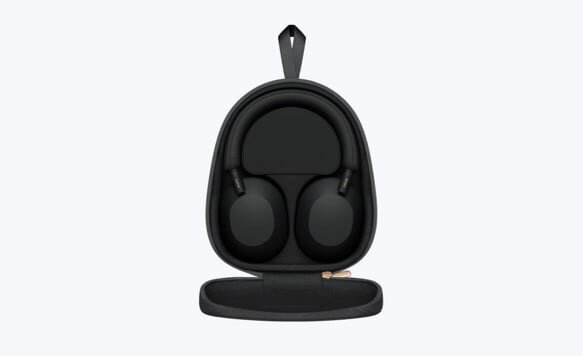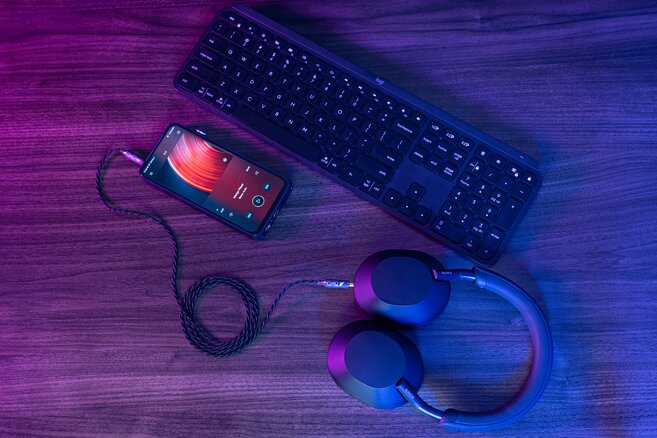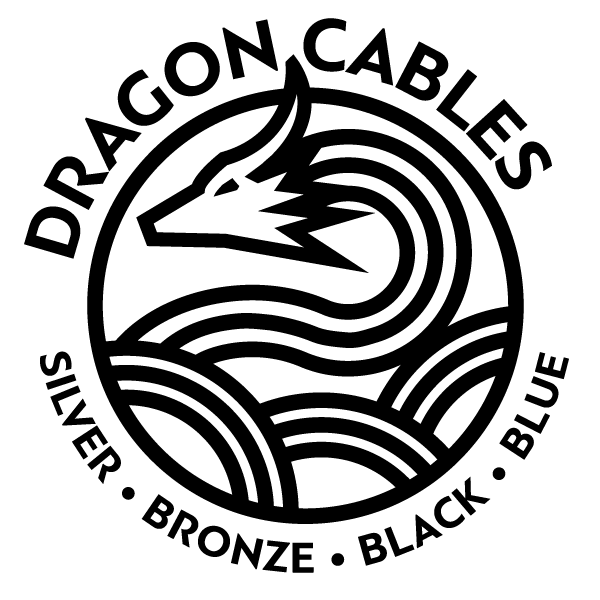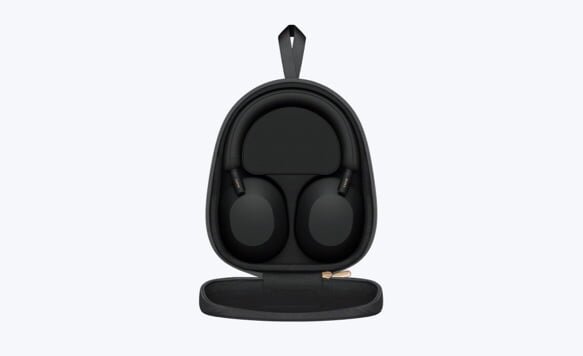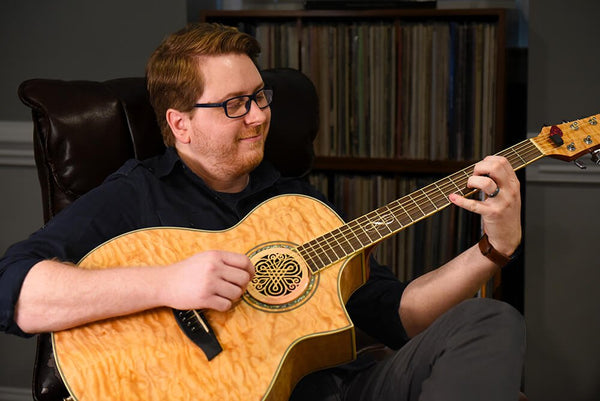Sony WH-1000XM5 Noise-Canceling Headphones Review
Read Time: Approx. 10 min.

The Best ANC Headphones Just Keep Getting Better
Guess what? Sony finally made a visual upgrade to the new WH-1000XM5 headphones. It was tricky trying to figure out the XM3 from the XM4 - even the XM2 looked similar enough in design and function. Needless to say, it was about time for a facelift on arguably the best noise-canceling headphones on the market.
There's no denying that Sony's name and quality maintain its reputation across its product lineup: you buy something by Sony and you know it's going to be a great product. So, apart from the styling redesign, let's see if the new WH-1000XM5 is a complete sonic redesign or just a pretty facelift.
Sony WH-1000XM5 Review Video
**Giveaway no longer active**

PROS
- Sleek styling redesign
- Top-of-class ANC
- More responsive controls
CONS
- A better seal might retain heat and sweat for some
- Not worth upgrading for XM4 owners
Design
Right off the bat, I'm going to mention something that Sony has been doing at least since the WF-1000XM4 earbuds - and that's Sony's focus on recyclable materials for their packaging. I appreciate their desire to use these kinds of environmentally-friendly materials not just due to their eco-sustainable impact but also because the packaging is much more rigid and protective than the previous cardboard boxes they used. I'm all for less waste, but I'm more jazzed that they protect my new investment better.
Let's go ahead and talk about the redesign. This year they overhauled the design elements of the headphone from the previous iterations, and it's much-needed. It's a noticeable difference and almost looks like a mix between the Bose 700 and the Apple Airpods Max, all with Sony's spin on it. Sony maintains their minimal button-less ear cups as well, which is a good move, as the sleek design is one of the biggest draws of the styling. It looks clean compared to other headphones on the market, which is why Bose and Apple both copy aspects of the 1000XM series in their latest iterations.
The headband is a big change, instead of being designed with a hinge-style where the ear cups can fold up into the headband when packed away, Sony went for a more traditional style fixed-band design. This allows for the ear cups to be rotated flat, and the accompanying hard case is designed the same way obviously. To be honest, I think I preferred the XM4 hinged design only because it takes up less real estate when packed in a bag, but I think the reason for the change is that it created fewer moving points for things to break. Bending always has a downside when it comes to technology. The padding is actually enhanced since the new headband design accommodates more padding along the entirety of the band. It's also a smaller diameter, which initially felt a little less sturdy to me, but it's strong enough - you're going to have some sort of flex with plastics.
The ear cups themselves have remained similar, with a minimal aesthetic and smooth and sleek design. Like the XM4, the only buttons you'll find on the left ear cup are the power on/off and the noise-canceling buttons. The power button doubles as the Bluetooth pairing switch and we'll walk you through how to set up your new XM5 later in this review. There is also a 3.5mm headphone jack, which is a sigh of relief, as some wireless headphone manufacturers are already starting to omit the analog headphone ports (like the Hifiman Ananda BT). On the right ear cup, you'll just find the single USB-C charging port. Don't worry, however, because most of the functionality of the headphones is retained in the Sony app (we'll go over that too in the setup section).
I'm a little torn on the materials of the XM5. The previous XM4 had a lot of plastic exposed and used leather materials for the padding. This year the headphones have a soft-touch material covering the ear cups, which really helps the grease and sweat from your fingers and handling stand out. I would consider the padding on the headband and ear cups improved overall, but the material is more rubberized than leather, resulting in some great sealing around the ears. The only downside is that this material doesn't breathe well, and retains the heat and sweat inside the ear cup too. This didn't particularly bother me too much, as I usually listen in a well-cooled office, so, if you live in a warmer climate or want to use these while working out they might provide some discomfort for some. I will say however that the new rubberized material on the ear pads is better at keeping moisture out and off the headphones.
Like the headphone, the carrying case has also been improved with a flatter design, and a magnetic compartment for your included accessories: the USB Type-A to USB-C charging cable and the 3.5mm single-entry headphone cable.
The comfort department has certainly improved. Due to the new headband design, the headphone fits more snugly and tighter around my head - which is great for the seal and overall sound. They're also a touch lighter than the previous generation. Again, I would consider the redesign a step up in both materials and fit. The only consideration I would make is that the seal of the ear cups is much tighter - and from a sound quality perspective greatly improved - unless you listen in a warm area. That would be my only markdown for an otherwise A++ headphone, and I don't think it would affect most listeners.
Sound
Let's face it, these are not audiophile-grade headphones, and should not be approached as so. That being said, they are one of the best-sounding consumer-grade headphones on the market, competing with other popular brands like the Sennheiser Momentum 4 and the Bose 700. Let's take a look at some of the different aspects of the headphone concerning the sound quality.
This year Sony did an overhaul of the driver, using a new 30mm unit with a soft thermoplastic polyurethane edge which supposedly enhances the noise canceling. The ear cup design uses a carbon fiber composite material to improve clarity as well. Bottom line, I can hear sonic improvements from the XM4. I’ll talk more about the noise-canceling in a bit, but the low end does seem tighter and more details are present throughout - it’s certainly a better balance and tuning than previous generations right out of the gate.
Turning on the headphones and pairing results in the "default" sound setting of the headphones - with noise-canceling enabled. One thing you will notice immediately after putting the headphones on is the simulated "blackness" - that is, the flipped sine wave of the outside noise being transmitted into the ear cup. That cancellation of noise makes for a simulated silence - albeit, not a true silence but one that effectively helps bring the music to the forefront. Sony is known for fun and V-shaped sound signatures in their devices, that is, boosting low and high frequencies while a dip in the midrange and the XM5 doesn't make much of a detour from that. You know what they say: "if it ain't broke..."
It's not going to replace your open-back planar magnetic cans, but it should be in every music lover's arsenal as a daily driver or especially for those on the move who want to tune out the world–or tune back in from time to time.
The Sony tuning is great for most genres, and the soundstage is close enough that the XM5 puts you right in the action. It’s not going to replace your open-back planar magnetic cans, but it should be in every music lover’s arsenal as a daily driver or especially for those on the move who want to tune out the world – or tune back in from time to time. Since I'm familiar with the typical sound of Sony headphones, I wanted to strike up something fun and energetic to see how the new drivers respond to the low and high-end boost. "Razzmatazz" by I Don’t Know How But They Found Me is a retro-funk bop that has some great slap and fun vocals. The rhythm of the song is set by the piano, but when the bass and kick enter the song gets really funky. I notice, right off the bat, that the lower registers on the XM5 sound clearer than the previous generation. Not that the XM4 sounded bloated, but there is a touch more control and transparency, likely in part due to the driver redesign and the ear cup material. It still has great energy, which is one of the best reasons I enjoy this headphone, so I don't necessarily notice a big difference in that department.
The WH-1000XM5, like the WH-1000XM4, doesn't have much of a soundstage. The headphones put you "in the action" of the music, most of the time feeling like you are sitting in the middle of the orchestra or standing right in front of the PA at a rock show. On the other side of that coin, performances can be extremely personal and intimate, with picked acoustic guitars and soft vocals it can truly be a spin-tingling reaction with the right song. "Where Did We Go Wrong" by Ben Harper is that song. The palm-muted electric guitar that's panned to the right sounds like you're right up against the pickups: the intonation is incredibly clean. The ping-pong delayed guitar gives you that ASMR effect, almost playing with your ears and directional sound. Ben's vocals have that pained emotion, asking the question "where did we go wrong?" It just hits all the right buttons.
Wireless Sound
Of course, I could say things like "oh, you feel like you're in the recording session" blah, blah, blah - but a lot of the actual and perceived fidelity comes from the source audio, resolution, and your connection. The Sony WH-1000XM5 has a 3.5mm unbalanced, single-entry headphone port, so for most high-fidelity cases, you're going to want to use a cable for the best sound quality. It's pretty simple. However, that is not to say that the XM5 does not sound good wireless, because it really, really does. Sony has outfitted the headphone with the latest high-resolution codecs to make sure that you get the best wireless audio quality possible. Bluetooth audio transmission has come a long way since just a few years ago, and some of the high-resolution audio codecs can transmit a large amount of data very efficiently, thus giving you (at least from a data packet perspective) true hires audio wirelessly. Sony's proprietary LDAC codec sounds great and combined with the ANC effectiveness it makes for a very passable and enjoyable high-resolution wireless experience. You also have the standard SBC and AAC codecs available as well. During my time testing, I never experienced dropout or connection issues, and the latest Bluetooth v5.2 pack the newest sound and coding improvements. It's not night and day, and you'll likely find no sonic difference if you're streaming high-resolution music, but the update is nice for future-proofing the headphone.
We'll talk more about the noise-canceling in the Features section, but sonically the XM5 improves on the previous generation with tighter bass response, more clarity in the mids and highs, and retains the top-of-class wireless performance for high-end consumer headphones.
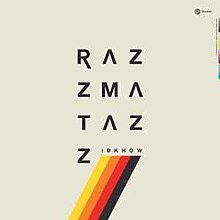
Razzmatazz
By IDKHOW
(Razzmatazz)
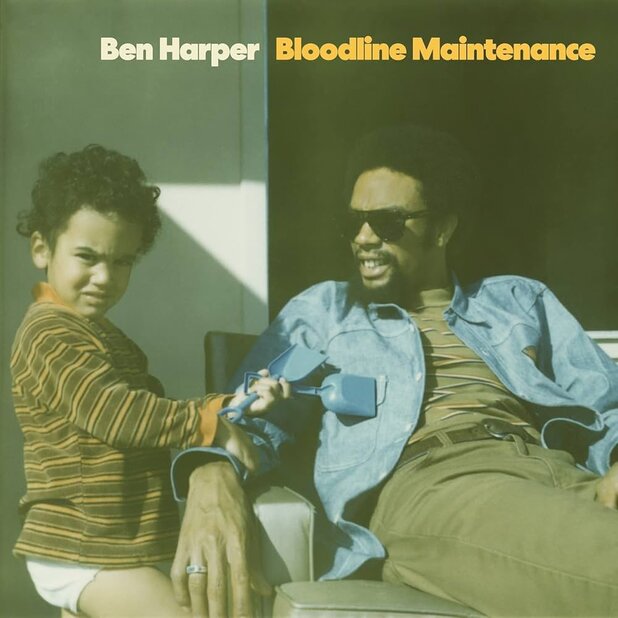
Where Did We Go Wrong?
By Ben Harper
(Bloodline Maintenance)

Symphony No. 1
By Sergei Rachmaninoff
(London Philharmonic Orchestra)

Cast No Shadow
By Oasis
(What's the Story Morning Glory)
Features
Most people are familiar with how ANC works, but here’s a quick recap. The headphone has microphones built in to pick up ambient noise outside and inside the earcup. The headphone takes the signal from the outside ambient noise, flips it, and broadcasts it through the speakers in the ear cups, effectively canceling out the noise other than the music during playback. The XM5 ANC is superb and is proficient at canceling out frequency bands across the spectrum depending on your environment. What makes it stand out however from previous generations is that whereas ANC used to sound like white or pink noise being filtered in with your music (thus dirtying up the fidelity). Now it’s surprisingly masked well, allowing your music to sound clear and detailed. I tried the headphone at a number of places with varying ambient noise levels and frequencies, and it performs just as well in high decibel environments as it does in softer ones. It’s hard to beat the XM5 when it comes to noise canceling and there are few that can compete with the sophistication of Sony’s tech.
But that’s just what puts Sony on the list. What sets them over the competition is the experience, and that’s where the touch and control integration comes into play. The headphone has a number of gesture controls that are very intuitive and useful while listening. On the right ear cup, you can slide your finger forward and back to skip tracks, up and down to adjust the volume, double tap to play or pause, and you can now hold to activate your voice assistant (Siri, Alexa, or Google Assistant). The responsiveness of these touch controls has been drastically improved over last year in my experience too.
There is also a sensor inside the headphone that automatically pauses the music when you take them off your head and will turn off after a certain amount of time if not resumed. Sony also incorporates some really great functionality for ambient noise when you want it. Say you’re listening to some music and your coworker comes over to ask a question. Simply place your palm over the earcup and the XM5 will automatically pause the music and activate the exterior microphones, allowing you to hear without having to take off the headphones. Another way is by allowing the speak-to-chat function, where all you have to do is talk, and the headphones will detect your voice and pause the music and activate the ambient sound setting like the flick of a switch.
Battery life is phenomenal at 30 hours with noise canceling. You can sqeeze out about 40 hours of battery life with ANC off. Bluetooth has also been updated to the latest version Bluetooth 5.2 which makes for more stable connections and longer ranges. Phone call quality was clear and noise canceling was incredibly effective at canceling out the ambient noise when I was talking in noisy environments. It’s pretty impressive what the noise reduction tech in phone calls can do now in the headset.
And that’s just the headphone. We haven’t even discussed the features in the app. Let’s take a quick look at how to set up your XM5 headphones with your device.
Setup
Setting up your XM5 is a pretty straightforward process after downloading the app. Available on both iOS and Android, head over to your app store and download the "Headphones Connect" application by Sony. The app will guide you through the rest of the steps:
1) Download the "Headphones Connect" app by Sony.
2) On the Welcome screen, check the box before clicking the "Start" button.
3) Next, make sure the headphones are powered on and click "Next."
4) Wait for the spinning wheel to find your headphone - if for some reason the headphone does not show up or get detected, you can always turn off the device and repeat steps 2-3. Otherwise feel free to register the headphone through your device's Bluetooth settings or from the list.
5) Once the app detects your XM5, you'll see it pop up at the top of the screen. Simply tap the image to proceed.
6) The next screen will display a prompt. Click next to continue.
7) The name of your headphone should pop up: "WH-1000XM5." Tap on this to select the headphone.
8) The following screen will show that your headphones have registered. Click "OK" to continue.
9) Setup is now complete and you can click "Go to the dashboard" to finish.
10) Welcome to the dashboard!
*Note: There will be a lot of pop up screens in between these steps to set up, so continue the setup according to your personal preferences. Steps 1-10 are the necessary steps to configure the XM5 headphones to your device.

The Headphones Connect application is one of the best experiences for wireless and noise-canceling headphones - giving you complete control to assign button operations, set EQ, dsee extreme, adjust adaptive ambient settings, and more. The app will even learn your environment and frequented locations - allowing the headphone to learn your behavior and settings to automatically adjust to your preferences when you need them. There are also some neat options for the headphone to learn the shape of your ear so that the optimizer influences your music accordingly. There are also specific streaming services like Deezer that use 360 Reality Audio - this is not compatible with all streaming services however. The app itself hasn’t changed much from the past year or so, and it’s compatible with both the WH and WF headphone and earphone lineup, including the WF-1000XM4. It's a sophisticated and robust user experience, and I have yet to find a headphone/app pairing that beats it.
Comparisons
So, how does the WH-1000XM5 Bluetooth headphone compare to the WH-1000XM4? It's notably different and improved on many levels. First off, the design overhaul is long overdue. The XM4 just couldn't compete with the sleeker and more modern looking Bose 700 and the Airpod Max. Even the competing Sennheiser Momentum 4 did a redesign. Styling is important to consumers, and the brands are responding accordingly. Along with the styling revamp, the structure of the XM5 has changed as well, doing away with the hinged headband. The new headband is more flexible and protective of the wires, so I'm for the change.
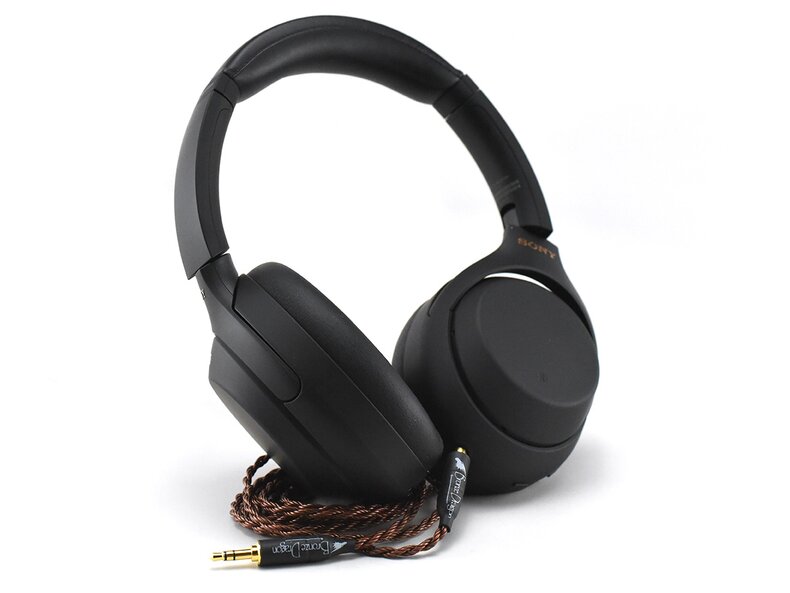
Pictured: Sony WH-1000XM4 Wireless Headphones
The new vegan leather padding is great on the XM5. The original XM4 leather breathed better in my opinion, but the XM5 has a tighter seal. The tighter seal is better for sound, but also retains sweat and moisture - which could be especially problematic if you live in a warmer climate. The newer headband also tightens up the clamping force, aiding the tighter seal. Comfort overall is a step up from the previous model.
The biggest improvement other than the styling is the driver design. Sony implemented a new 30mm driver and ear cup materials that make a noticeable sonic difference from the previous generation headphone. Right out of the gate I notice that the low end still retains the signature Sony "slap" but the bass is tighter and more transparent than the XM4. Also the mids and highs are crisper with a touch more top end sparkle, resulting in a sound that is similar enough to the XM4, but improved dynamically. The active noise-cancellation also helps with the better dynamics, since the effectiveness of ANC tech improves year after year.
The Sony Headphones Connect application which controls a lot of the features of the headphone hasn't changed much from the version last year, but it doesn't really need to since the headphones don't necessarily have any additional functionality. The features are basically just more responsive and accurate this year, which in itself is a huge deal. Chat-to-speak is quicker at detecting your voice. The gesture controls are more responsive and as a result I didn't have to keep attempting to swipe if it didn't read my actions. All of these small and subtle improvements make for a dramatically better and more satisfying user experience than the WH-1000XM4 headphones.
Dragon Cables
[Silver Dragon Portable Headphone Cable, Bronze Dragon Portable Headphone Cable]
For my listening sessions I paired the Sony WH-1000XM5 with both a Silver Dragon and Bronze Dragon Portable Cable. I was surprised at the difference that each cable brought out in the overall sound of the headphone. I would argue that both are great options, but if you’re more of the analytical listening persuasion then the Silver Dragon will bring out a bit more detail and top end sparkle. I think the Black Dragon helps to control the low end weight and tighten it up. Both cables are a big boost over the included factory cable.
Our HiFi Audio Dragon Cables bring out more of what you love in your music and audio gear. If you love your headphones but wish they had a bit more top-end sparkle - a Silver Dragon Headphone Cable would be a great option. If your USB cables keep dying - as many stock cables do - then check out our quality USB Audio Cables. We say time and time again that materials matter, and our audio cables and custom geometries actually help to bring out those desired properties in your gear and music. We make tons of custom options for our customers so that you can get the right HiFi Audio cable for your exact needs. If you have any questions feel free to Contact Us and we'll be more than happy to help.
Verdict
I think what I said last year about the XM4 still applies: the XM series of headphones from Sony is a smart device in that it incorporates well into your day to day, and smart enough to know how to not get in the way. The sound quality is top notch, the noise-canceling cant be beat, but it’s the user experience and functionality that makes the Sony WH-1000XM5 Headphones best in show. The redesign is overdue, but worth the wait. The styling is much sexier, and the fit and comfort is somehow even better than last year. Those craving a wired listening experience can use our Silver Dragon Portable Headphone Cable or Bronze Dragon Headphone Cable to do so. With two different sound signatures, these Dragon Audio Cables will enhance the sonic performance of the XM5 headphones.
Now, XM4 owners - is it worth an upgrade? I'd say so. The driver redesign does make for noticeable improvements in the sound quality. Better dynamics, more clarity, and just an overall upgrade to the presentation. The other thing that makes it a must-buy in my book is the greatly-improved touch controls. The XM3 and XM4 just had too many gestures that wouldn't register, resulting in repeated attempts to do what I wanted the headphones to do. It became frustrating a lot of the time. The XM5's responsiveness nails it. It's undoubtedly the better pick, a worthy upgrade, and objectively improved in every way. Do you want the best noise-canceling wireless headphone on the market? The XM5 is the one.
Featured Products
Related Videos
Sony WH-1000XM5 Unboxing Video
Sony WF-1000XM5 Earbuds Review: TRULY The Best?
Beats Studio Pro Headphones Review & Sony WH-1000XM5 Comparison
What's in the Box
Specifications
GENERAL FEATURES
- Cord Length: approx. 3.94 ft
- Cord type: Single-sided (detachable)
- Driver Unit: 11.82 in
- Frequency Response: 4 Hz–40,000 Hz (JEITA)
- Frequency Response (Active Operation): 4 Hz–40,000 Hz
- Frequency Response (Bluetooth® Communication): 20 Hz–20,000 Hz (44.1 kHz Sampling) 20 Hz–40,000 Hz (LDAC 96 kHz Sampling 990 kbps)
- Headphone Type: Closed, dynamic
- Impedance (Ohm): 48 ohm (1 kHz) (when connecting via the headphone cable with the unit turned on), 16 ohm (1 kHz) (when connecting via the headphone cable with the unit turned off)
- Input(s): Stereo Mini Jack
- Magnet: Neodymium
- Passive Operation: Yes
- Plug: Gold-plated L-shaped stereo mini plug
- Sensitivities (dB/mW): 102 dB (1 kHz) / mW (when connecting via the headphone cable with the unit turned on), 100 dB (1 kHz) / mW (when connecting via the headphone cable with the unit turned off)
- Volume Control: Touch Sensor
- Wearing Style: Over Ear
- DSEE Extreme: Yes
- Ambient Sound Mode: Yes
- Noise Canceling
- Atmospheric Pressure Optimizing: Yes
- Personal NC Optimizer: Auto NC Optimizer
- Quick Attention: Yes
BATTERY
- BATTERY LIFE (CONTINUOUS COMMUNICATION TIME): Max. 24 hrs (NC ON) , Max. 32 hrs (NC OFF)
- Battery Charge Method: USB
- Battery Charge Time: Approx. 3.5 hrs
- Battery Life (continuous music playback time): Max. 30 hrs (NC ON), Max. 40 hrs (NC OFF)
BLUETOOTH® SPECIFICATION
- Bluetooth® version Bluetooth Specification: Version 5.2
- Effective Range: 32.81 ft
- FREQUENCY RANGE: 2.4 GHz band (2.4000–2.4835 GHz)
- Profile: A2DP, AVRCP, HFP, HSP
- Supported Audio Format(s): SBC, AAC, LDAC
- Supported Content Protection: SCMS-T
SIZE & WEIGHT
- Weight: Approx. 8.82 oz






